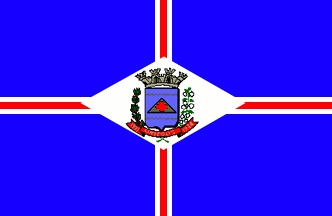 image by Dirk Schönberger,
18 January 2013
image by Dirk Schönberger,
18 January 2013Based on: http://www.rinopolis.sp.gov.br/index.php/simbolos

Last modified: 2013-02-02 by ian macdonald
Keywords: sao paulo | rinópolis |
Links: FOTW homepage |
search |
disclaimer and copyright |
write us |
mirrors
 image by Dirk Schönberger,
18 January 2013
image by Dirk Schönberger,
18 January 2013
Based on:
http://www.rinopolis.sp.gov.br/index.php/simbolos
A blue flag with an upright narrow red cross, bordered white, overlain by a white lozenge bearing the municipal arms.
Official website at
http://www.rinopolis.sp.gov.br
Dirk Schönberger,
18 January 2013
Rinópolis was founded in 1927, when the Lélio Piza & Irmãos company sold plots from the Goataporanga Estate, located on the left bank of river Aguapeí (aka Feio). Colonel Eugênio Rino, the head of a local rural family, commissioned his two sons, Domingos Rino and Eugênio Rino Filho, and his son-in-law, Francisco Nascimento Silva, to evaluate the fertility and salubrity of the plots offered for sale, which they did with a representative of the company, Orozinho Durval. It took ten days to the experts to travel from Pirajuí to Goataporanga, first by car and then on horses through a narrow trail cleared in the primary forest. The outcome of the mission was positive and Rino purchased a piece of land, asking engineer Marcondes Filho to divide the area into plots. The engineer lost his way near river Itaúna and was eventually found by Francisco Nascimento Silva, Vicente Rino and Eugênio Rino Filho; four days later, the expedition reached the source of brook Brí, where they placed the cornerstone of the new settlement. The first colonists settled the place in 1928, clearing the forest, planting coffee and sowing grain; they were visited in 1930 by the Bishop of Botucatu, Ático Euzébio da Rocha, who celebrated the first mess in the colony.
The district of Rinópolis was established on 4 August 1937, as part of the municipality of Araçatuba, and transferred to the municipality of Tupã by Decree No. 9,775 of 30 November 1938. The municipality of Rinópolis was established by State Decree-Law No. 14,334 of 30 November 1944 and inaugurated on 1 January 1945.
The symbols of Rinópolis are prescribed in Article 3 of the Municipal
Constitution, adopted on 27 March 1990, as "the flag, the coat of arms
and the anthem".
http://www.camarafacil.com.br/srv08/cmrinopolis/_arquivos/documentos/normas/Leiorganica.pdf - Municipal Constitution
The flag and arms are prescribed by Municipal Law No. 438 of 14 April 1969.
The flag is blue with a red cross fimbriated in white. In the middle is placed a white lozenge charged with the municipal coat of arms.
The flag follows the tradition of Portuguese heraldry. The coat of arms represents the municipal government while the white lozenge represents the town as the seat of the municipality. White is a symbol of peace, friendship, work, prosperity and purity. The arms of the cross represent the municipal power spreading all over the municipal territory. Red is a symbol of determination, intrepidity, courage and valiance, courage, and valiance. The blue quarters represent the rural estates located on the municipal territory. Blue is a symbol of justice, nobleness, perseverance, zeal and loyalty.
Photos of the flag
http://www.camarafacil.com.br/srv08/cmrinopolis/_arquivos/fotos/galeria/camara04.jpg
http://www.camararinopolis.sp.gov.br/_portal/noticias/ver.asp?id=135
http://www.camararinopolis.sp.gov.br/_portal/noticias/ver.asp?id=140
http://www.camararinopolis.sp.gov.br/_portal/noticias/ver.asp?id=161
http://www.camararinopolis.sp.gov.br/_portal/noticias/ver.asp?id=196
http://www.camararinopolis.sp.gov.br/_portal/noticias/ver.asp?id=247
http://www.camararinopolis.sp.gov.br/_portal/noticias/ver.asp?id=276
The coat of arms is "A Samnitic shield surmounted by a six-towered mural crown argent, azure an equilateral triangle argent charged with a stylized trefoil of four petals gules, in chief and base tow fesses way argent. The shield supported dexter by a branch of coffee fructed proper and sinister by a plant of cotton flowered proper. Below the shield a scroll gules inscribed with the municipality's name surrounded by the years '1937' and '1944' all argent."
The Samnitic shield, of the first style of shield used in Portugal
under French influence, evokes the Latin race of the colonizers and
main builders of the Brazilian nation.
The six-towered mural crown is the symbol of a third-rank town, seat
of a municipality.
Azure is a symbol of justice, nobleness, perseverance, zeal and loyalty.
The equilateral triangle is a symbol of equality and divine
perfection. The triangle also represents Domingos Rino, Eugênio Rino
Filho and Francisco Nascimento da Silva, the two sons and the son-in-
law of Eugênio Rino, owner of the Goataporanga Estate, who
commissioned them in 1927 to evaluate the economical potential of the
estate, which was succeeded by the town of Rinópolis. Argent is a
symbol of peace, work, friendship, equity, progress, truth, temperance
and purity.
The trefoil is a symbol of fortune representing the blossoming of the
town established between river Itaúna and brook Brí, which are
represented by the two fesses wavy. Red is a symbol of audacity,
intrepidity, courage and valiance.
Coffee and cotton are the basic sources of income for the
municipality, being the main products of the generous and fertile soil.
The years "1937" and "1944" are those of the establishment of the
district and of the municipality of Rinópolis, respectively.
Ivan Sache, 19 January 2013